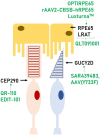Leber congenital amaurosis/early-onset severe retinal dystrophy: current management and clinical trials
- PMID: 33712480
- PMCID: PMC8961750
- DOI: 10.1136/bjophthalmol-2020-318483
Leber congenital amaurosis/early-onset severe retinal dystrophy: current management and clinical trials
Abstract
Leber congenital amaurosis (LCA) is a severe congenital/early-onset retinal dystrophy. Given its monogenic nature and the immunological and anatomical privileges of the eye, LCA has been particularly targeted by cutting-edge research. In this review, we describe the current management of LCA, and highlight the clinical trials that are on-going and planned. RPE65-related LCA pivotal trials, which culminated in the first Food and Drug Administration-approved and European Medicines Agency-approved ocular gene therapy, have paved the way for a new era of genetic treatments in ophthalmology. At present, multiple clinical trials are available worldwide applying different techniques, aiming to achieve better outcomes and include more genes and variants. Genetic therapy is not only implementing gene supplementation by the use of adeno-associated viral vectors, but also clustered regularly interspaced short palindromic repeats (CRISPR)-mediated gene editing and post-transcriptional regulation through antisense oligonucleotides. Pharmacological approaches intending to decrease photoreceptor degeneration by supplementing 11-cis-retinal and cell therapy's aim to replace the retinal pigment epithelium, providing a trophic and metabolic retinal structure, are also under investigation. Furthermore, optoelectric devices and optogenetics are also an option for patients with residual visual pathway. After more than 10 years since the first patient with LCA received gene therapy, we also discuss future challenges, such as the overlap between different techniques and the long-term durability of efficacy. The next 5 years are likely to be key to whether genetic therapies will achieve their full promise, and whether stem cell/cellular therapies will break through into clinical trial evaluation.
Keywords: degeneration; dystrophy; genetics; retina.
© Author(s) (or their employer(s)) 2022. Re-use permitted under CC BY. Published by BMJ.
Conflict of interest statement
Competing interests: The authors alone are responsible for the content and writing of this article. MM consults for MeiraGTx Ltd.
Figures

Similar articles
-
Leber congenital amaurosis/early-onset severe retinal dystrophy: clinical features, molecular genetics and therapeutic interventions.Br J Ophthalmol. 2017 Sep;101(9):1147-1154. doi: 10.1136/bjophthalmol-2016-309975. Epub 2017 Jul 8. Br J Ophthalmol. 2017. PMID: 28689169 Free PMC article. Review.
-
An Update on Gene Therapy for Inherited Retinal Dystrophy: Experience in Leber Congenital Amaurosis Clinical Trials.Int J Mol Sci. 2021 Apr 26;22(9):4534. doi: 10.3390/ijms22094534. Int J Mol Sci. 2021. PMID: 33926102 Free PMC article. Review.
-
Genetic and clinical findings in a Chinese cohort with Leber congenital amaurosis and early onset severe retinal dystrophy.Br J Ophthalmol. 2020 Jul;104(7):932-937. doi: 10.1136/bjophthalmol-2019-314281. Epub 2019 Oct 19. Br J Ophthalmol. 2020. PMID: 31630094
-
Gene Therapy in Hereditary Retinal Dystrophies: The Usefulness of Diagnostic Tools in Candidate Patient Selections.Int J Mol Sci. 2023 Sep 6;24(18):13756. doi: 10.3390/ijms241813756. Int J Mol Sci. 2023. PMID: 37762059 Free PMC article. Review.
-
RPE65 mutations in Leber congenital amaurosis, early-onset severe retinal dystrophy, and retinitis pigmentosa from a tertiary eye care center in India.Ophthalmic Genet. 2024 Jun;45(3):303-312. doi: 10.1080/13816810.2024.2309559. Epub 2024 Feb 7. Ophthalmic Genet. 2024. PMID: 38323530
Cited by
-
The Clinical Findings, Pathogenic Variants, and Gene Therapy Qualifications Found in a Leber Congenital Amaurosis Phenotypic Spectrum Patient Cohort.Int J Mol Sci. 2024 Jan 19;25(2):1253. doi: 10.3390/ijms25021253. Int J Mol Sci. 2024. PMID: 38279252 Free PMC article.
-
Efficacy and Safety of Voretigene Neparvovec in RPE65-Retinopathy: Results of a Phase III Trial in Japan.Ophthalmol Sci. 2025 Jul 7;5(6):100876. doi: 10.1016/j.xops.2025.100876. eCollection 2025 Nov-Dec. Ophthalmol Sci. 2025. PMID: 40910102 Free PMC article.
-
Tissue Specific DNA Repair Outcomes Shape the Landscape of Genome Editing.Front Genet. 2021 Sep 3;12:728520. doi: 10.3389/fgene.2021.728520. eCollection 2021. Front Genet. 2021. PMID: 34539755 Free PMC article. Review.
-
Leber's Congenital Amaurosis: Current Concepts of Genotype-Phenotype Correlations.Genes (Basel). 2021 Aug 19;12(8):1261. doi: 10.3390/genes12081261. Genes (Basel). 2021. PMID: 34440435 Free PMC article. Review.
-
Unlocking therapeutic potential: dual gene therapy for ameliorating the disease phenotypes in a mouse model of RPE65 Leber congenital amaurosis.Front Med (Lausanne). 2024 Jan 9;10:1291795. doi: 10.3389/fmed.2023.1291795. eCollection 2023. Front Med (Lausanne). 2024. PMID: 38264046 Free PMC article.
References
Publication types
MeSH terms
Substances
Supplementary concepts
Grants and funding
LinkOut - more resources
Full Text Sources
Other Literature Sources
Research Materials
